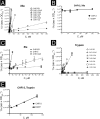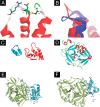Interactions outside the proteinase-binding loop contribute significantly to the inhibition of activated coagulation factor XII by its canonical inhibitor from corn
- PMID: 24706752
- PMCID: PMC4022879
- DOI: 10.1074/jbc.M114.553735
Interactions outside the proteinase-binding loop contribute significantly to the inhibition of activated coagulation factor XII by its canonical inhibitor from corn
Abstract
Activated factor XII (FXIIa) is selectively inhibited by corn Hageman factor inhibitor (CHFI) among other plasma proteases. CHFI is considered a canonical serine protease inhibitor that interacts with FXIIa through its protease-binding loop. Here we examined whether the protease-binding loop alone is sufficient for the selective inhibition of serine proteases or whether other regions of a canonical inhibitor are involved. Six CHFI mutants lacking different N- and C-terminal portions were generated. CHFI-234, which lacks the first and fifth disulfide bonds and 11 and 19 amino acid residues at the N and C termini, respectively, exhibited no significant changes in FXIIa inhibition (Ki = 3.2 ± 0.4 nm). CHFI-123, which lacks 34 amino acid residues at the C terminus and the fourth and fifth disulfide bridges, inhibited FXIIa with a Ki of 116 ± 16 nm. To exclude interactions outside the FXIIa active site, a synthetic cyclic peptide was tested. The peptide contained residues 20-45 (Protein Data Bank code 1BEA), and a C29D substitution was included to avoid unwanted disulfide bond formation between unpaired cysteines. Surprisingly, the isolated protease-binding loop failed to inhibit FXIIa but retained partial inhibition of trypsin (Ki = 11.7 ± 1.2 μm) and activated factor XI (Ki = 94 ± 11 μm). Full-length CHFI inhibited trypsin with a Ki of 1.3 ± 0.2 nm and activated factor XI with a Ki of 5.4 ± 0.2 μm. Our results suggest that the protease-binding loop is not sufficient for the interaction between FXIIa and CHFI; other regions of the inhibitor also contribute to specific inhibition.
Keywords: Blood Coagulation Factors; Enzyme Kinetics; Enzyme Mechanisms; Protease Inhibitor; Protein Expression; Protein-Protein Interactions; Serine Protease.
© 2014 by The American Society for Biochemistry and Molecular Biology, Inc.
Figures






Similar articles
-
Assessment of the protein interaction between coagulation factor XII and corn trypsin inhibitor by molecular docking and biochemical validation.J Thromb Haemost. 2017 Sep;15(9):1818-1828. doi: 10.1111/jth.13773. Epub 2017 Aug 9. J Thromb Haemost. 2017. PMID: 28688220 Free PMC article.
-
The corn inhibitor of activated Hageman factor: purification and properties of two recombinant forms of the protein.Protein Expr Purif. 1998 Jul;13(2):143-9. doi: 10.1006/prep.1998.0882. Protein Expr Purif. 1998. PMID: 9675055
-
Structural determinants of the bifunctional corn Hageman factor inhibitor: x-ray crystal structure at 1.95 A resolution.Biochemistry. 1998 Nov 3;37(44):15277-88. doi: 10.1021/bi9812266. Biochemistry. 1998. PMID: 9799488
-
Inhibitory properties of separate recombinant Kunitz-type-protease-inhibitor domains from tissue-factor-pathway inhibitor.Eur J Biochem. 1996 Jan 15;235(1-2):310-6. doi: 10.1111/j.1432-1033.1996.0310f.x. Eur J Biochem. 1996. PMID: 8631347
-
Canonical protein inhibitors of serine proteases.Cell Mol Life Sci. 2003 Nov;60(11):2427-44. doi: 10.1007/s00018-003-3120-x. Cell Mol Life Sci. 2003. PMID: 14625687 Free PMC article. Review.
Cited by
-
New Infestin-4 Mutants with Increased Selectivity against Factor XIIa.PLoS One. 2015 Dec 15;10(12):e0144940. doi: 10.1371/journal.pone.0144940. eCollection 2015. PLoS One. 2015. PMID: 26670620 Free PMC article.
-
Factor XII Activation Promotes Platelet Consumption in the Presence of Bacterial-Type Long-Chain Polyphosphate In Vitro and In Vivo.Arterioscler Thromb Vasc Biol. 2018 Aug;38(8):1748-1760. doi: 10.1161/ATVBAHA.118.311193. Arterioscler Thromb Vasc Biol. 2018. PMID: 30354195 Free PMC article.
-
Recent advances in the discovery and development of factor XI/XIa inhibitors.Med Res Rev. 2018 Sep;38(6):1974-2023. doi: 10.1002/med.21503. Epub 2018 May 4. Med Res Rev. 2018. PMID: 29727017 Free PMC article. Review.
-
Assessment of the protein interaction between coagulation factor XII and corn trypsin inhibitor by molecular docking and biochemical validation.J Thromb Haemost. 2017 Sep;15(9):1818-1828. doi: 10.1111/jth.13773. Epub 2017 Aug 9. J Thromb Haemost. 2017. PMID: 28688220 Free PMC article.
-
Structure, Function and Protein Engineering of Cereal-Type Inhibitors Acting on Amylolytic Enzymes.Front Mol Biosci. 2022 Mar 25;9:868568. doi: 10.3389/fmolb.2022.868568. eCollection 2022. Front Mol Biosci. 2022. PMID: 35402513 Free PMC article. Review.
References
-
- Mahoney W. C., Hermodson M. A., Jones B., Powers D. D., Corfman R. S., Reeck G. R. (1984) Amino acid sequence and secondary structural analysis of the corn inhibitor of trypsin and activated Hageman factor. J. Biol. Chem. 259, 8412–8416 - PubMed
-
- Lei M. G., Reeck G. R. (1987) Resynthesis by factor XIIa of the trypsin-cleaved peptide bond in the corn protease inhibitor. Thromb. Res. 45, 87–94 - PubMed
-
- Hojima Y., Pierce J. V., Pisano J. J. (1980) Hageman factor fragment inhibitor in corn seeds: purification and characterization. Thromb. Res. 20, 149–162 - PubMed
Publication types
MeSH terms
Substances
LinkOut - more resources
Full Text Sources
Other Literature Sources

